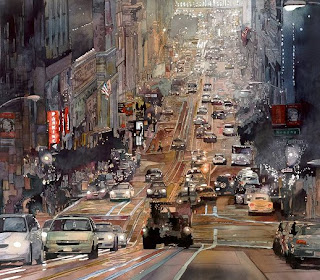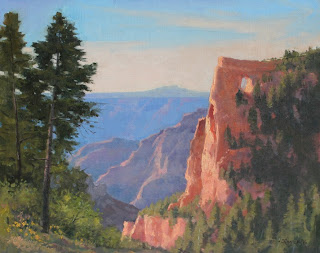Watercolor Artist Drawn to Complexity, Challenge and the Importance of Design
Humanity
seems to flow through each of John Salminen’s paintings. Whether it is through our connection to
nature, our desire for solitude, or the taken-for-granted moments of our busy
days, it’s hard not to see ourselves and our own personal experiences--or make
assumptions about meaning, in each of his very detailed watercolors.
His
scenes are often expansive, very complex, and involve outdoor spaces in nature
or urban settings where people are caught passing the time, doing business,
rushing to be somewhere else, or simply living their daily lives.
Yet
Salminen says his initial choices are not driven by subject matter but rather
the potential as a painting, focusing on strong design and composition
possibilities first. The daily
life found in his paintings is his last consideration, he confessed, but it’s
often what other people relate to most.
“I
try to create mood and feeling in the scene, either as the initial reference
offered or as re-envisioned by me by carefully controlling the light and shadow
through the use of value,” he said.
“My goal is to represent the scene in a believable manner, accurately
portraying details while controlling the atmosphere. If I create a convincing
mood in the painting the viewers will provide their own stories based on what
they bring to the painting.”
And
so we do. Salminen’s paintings are
equal parts thoughtful and thought provoking. His detailed scenes are realistic yet subtly dream-like,
giving viewers much to notice and ponder.
His use of value and color help to create the depth, complexity and
perspective that his watercolor paintings are known for, whether we are viewing
a quiet rainy moment in the park or a noisy, congested city thoroughfare.
“I
use value--darks and lights, to create the illusion of light and shadow and to
lead the viewer through the painting,” he said. “We perceive the world in
light and shadow and the more I can learn about using value, the better chance
I have of creating the look and feel of a scene.”
Some
of his paintings reveal a single person while others pan over large cityscapes
filled with thousands of motorists and busy citizens. All of them are complex scenes, ripe for our own reflections
and personal interpretations. And
while many of his paintings include people—and the personal stories we might
project onto them, they also strongly emphasize the context – the unique and
recognizable places where our lives actually unfold.
“I'm
drawn to complex scenes because of the unlimited design choices a busy
composition presents,” he said. “I approach each painting as an
organizational challenge and the more complicated the scene is, the more
options I have.”
Salminen
said that it requires a lot of planning to be able to lead the viewer through a
complex scene without making the experience chaotic, sharing that some aspects
of the composition need to be de-emphasized while others are
strengthened.
“Both
value and color are valuable in reaching this goal,” he said. “I often need to add or delete objects
or people to achieve the desired effect.
Busy city scenes provide all of the complex detail I like to use and create
the organizational challenges that I enjoy.”
Whether
he is painting a long street, a tall tower, or finding ways to create a certain
mood in a scene, Salminen’s use of value, and his strategic use of color,
always play key roles in the depth he conveys in each of his paintings.
“I
like to stage the scene in neutrals by using complimentary mixes and the 'mud'
that builds up in the middle of my palette as a result of mixing my colors,” he
said. “My neutral grays are the result of contributions from all of my
colors. Once the stage is set by the neutrals, I drop in some more intense
local color as accents. Because I feel that too much color spread across
a painting can become chaotic, I use pure color sparingly.”
As
a painter, Salminen began as an abstract expressionist and now defines himself
as a transparent watercolorist.
“I think every great painting, whether abstract or representational,
rests upon a foundation of design,” he said. “My background as an
abstract expressionist gave me a love of paint for paint's sake and my early
exposure to watercolor and the California 'fast and loose' school of art gave
me an awareness of the importance of design.”
Originally a Music major in college, Salminen decided that
he did not have the ‘ear’ for Music, so he switched to another subject of equal
interest -- Art. After graduation he began teaching high school art, and
continued to teach for 33 years, a decision that allowed him the time to hone
his own skills as a painter and provided him with the freedom to paint when and
what he wished.
“The
students made teaching a wonderful job for me and I still have contact with
many former students who are still producing art.”
Today, Salminen splits his time between teaching workshops all
over the U.S. and Canada, and painting in his home studio in Duluth,
Minnesota. Painting and teaching
are very different activities, he said, but they complement each other
well.
“Painting
is solitary and introspective while teaching is outgoing and social,” he
said. “Teaching exposes me to new
work and ideas and it causes me to continually think about and clarify my own
perceptions. I have made many friends throughout the watercolor community
due to my experiences as a teacher. We all share a common challenge as we
move ahead to the next steps in our artistic development, learning from each
other along the way.”
-----
John Salminen earned his bachelor’s and master's degrees from the University of Minnesota. John is a signature member of numerous art societies, including the American Watercolor Society, The National Watercolor Society, the Watercolor USA Honor Society, the Transparent Watercolor Society of America, Allied Artist and Watercolor West. John has won more than 200 awards in national and international exhibitions, and is a frequent juror of national and international shows. John's work has been featured in many national and international magazines and books, including most recently L'Art de L'Aquarelle, the Chinese Watercolor Journal, and many others. John is represented by the Stremmel Gallery in Reno, Nevada and the Newman and Saunders Gallery in Pennsylvania. To learn more about John, or to view his paintings, visit his website at www.johnsalminen.com.
John Salminen earned his bachelor’s and master's degrees from the University of Minnesota. John is a signature member of numerous art societies, including the American Watercolor Society, The National Watercolor Society, the Watercolor USA Honor Society, the Transparent Watercolor Society of America, Allied Artist and Watercolor West. John has won more than 200 awards in national and international exhibitions, and is a frequent juror of national and international shows. John's work has been featured in many national and international magazines and books, including most recently L'Art de L'Aquarelle, the Chinese Watercolor Journal, and many others. John is represented by the Stremmel Gallery in Reno, Nevada and the Newman and Saunders Gallery in Pennsylvania. To learn more about John, or to view his paintings, visit his website at www.johnsalminen.com.
-----
Photos above, from top to bottom:
“Market
Street,” 35”x35”
“Spring,” 23”x34”
“Evening Cable Car,” 24.5”x28
“Diamond District,” 25.5”x30”
“Eiffel Tower,” 36”x24.5”
“Fifth Avenue,” “32”x39”
“Peace Hotel,” 24.5”x36.25”
-----
Scottsdale Artists’ School, a 501(c)(3) nonprofit, was founded in 1983 by a group of dedicated artists and community leaders. Tucked away in the heart of the Scottsdale Arts District, located in a charming historic schoolhouse, the School features over 160 workshops and classes taught annually by the nation’s leading artists. Scottsdale Artists’ School is considered a leader in traditional, representational art training for all skill levels—from absolute beginner to professional artist.
--Written by Denise Kronsteiner
+++









Comments
Post a Comment